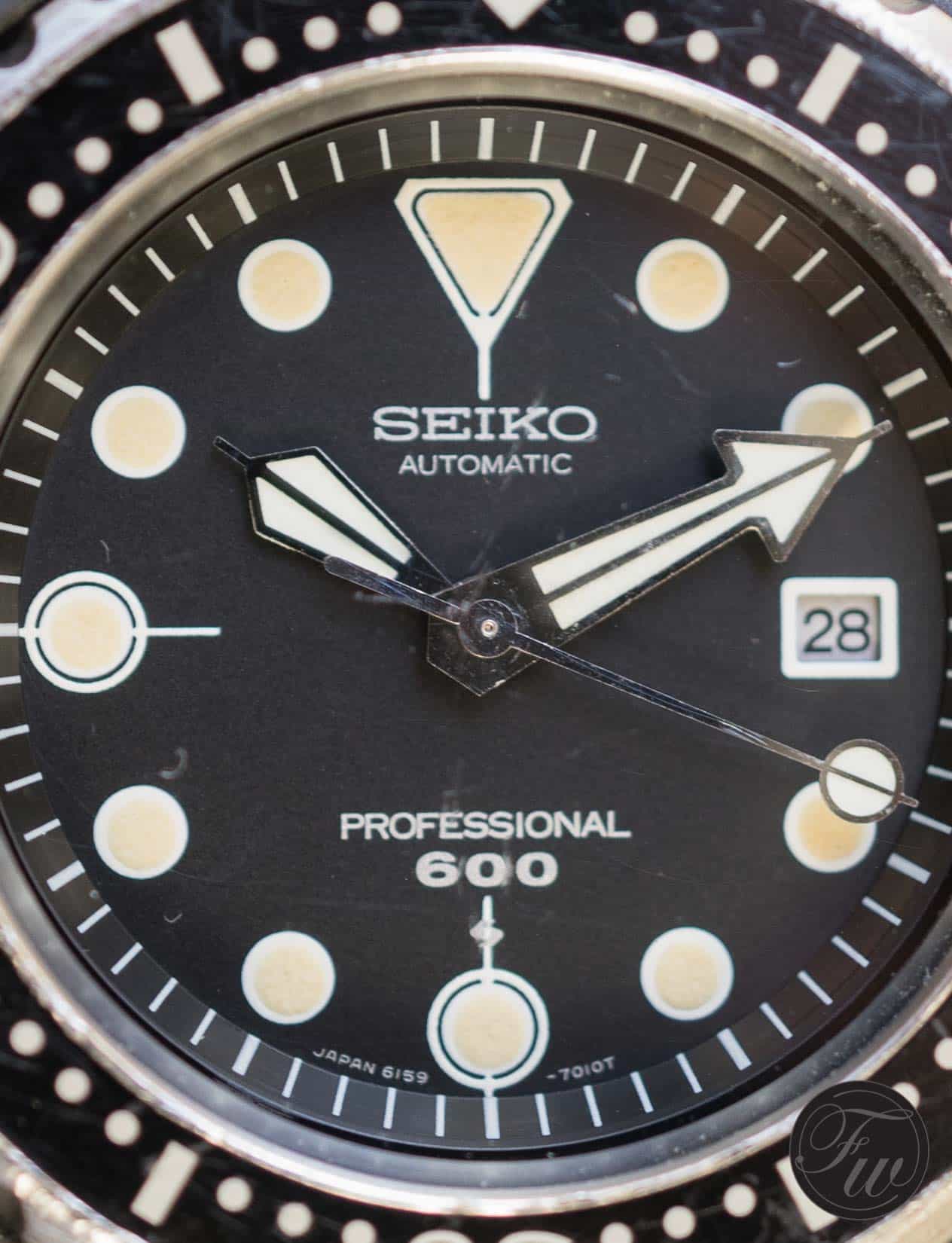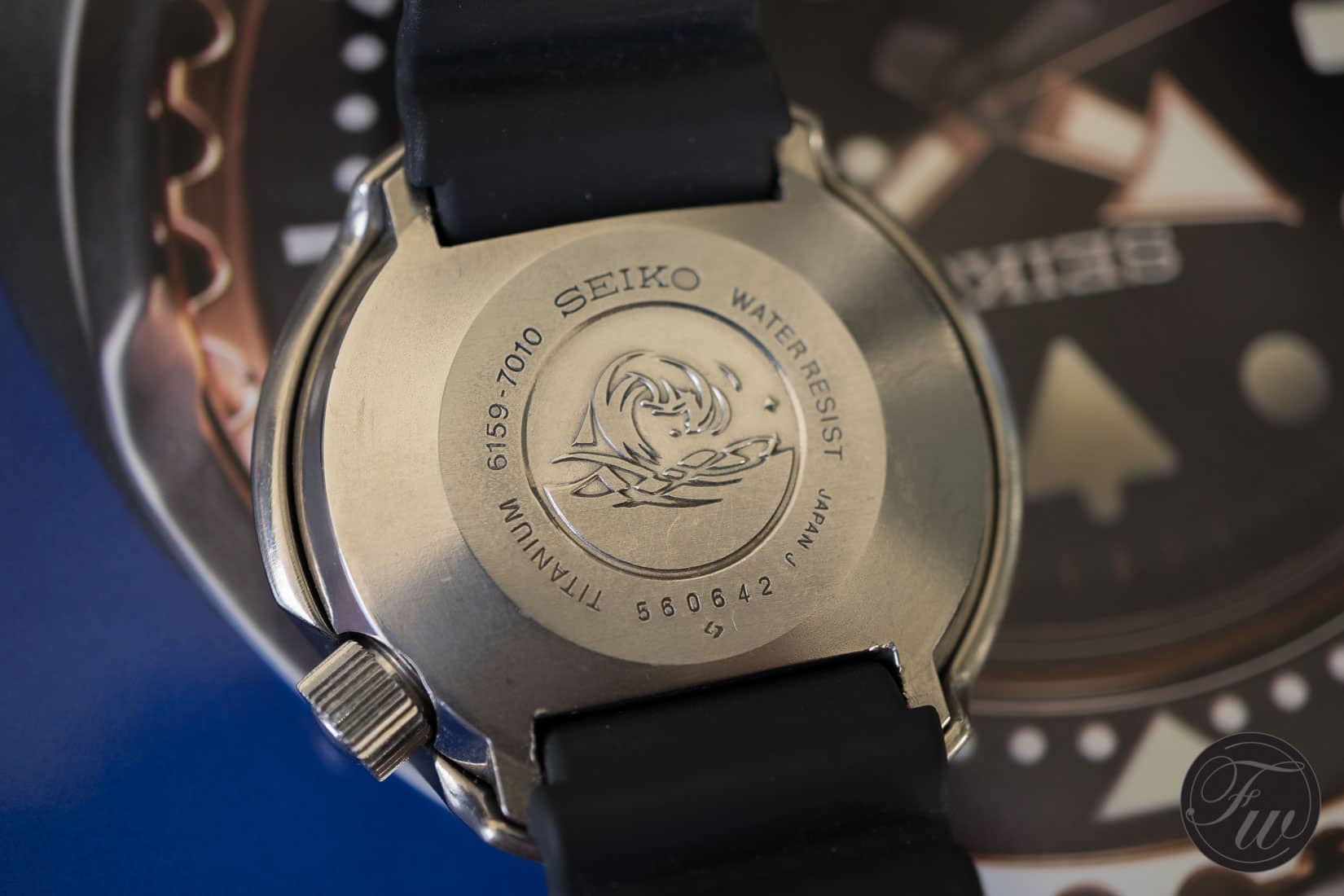#TBT Seiko 6159-7010 Tuna
Normally Michael Stockton takes care of our weekly recurring TBT feature, but due to extensive traveling he was unable to this week. To keep this installment of TBT true to him, I would like to talk about the Seiko 6159-7010 Tuna that I bought a couple of months ago. Lately, Mike is blaming me for his shopping spree concerning vintage Speedmaster watches. I actually delivered his latest (as far as I know that is) to him in Frankfurt two weeks ago, I am sure he will dedicate a TBT or Speedy Tuesday to that watch. While he blames me for becoming a Speedmaster collector (or hoarder), I have to blame him for me buying all these Seikos in the last two years.
After finding myself wearing the Seiko Marinemaster 300M (SBDX001) a lot, I was also drawn to the Seiko Tuna, or Puck, or just reference 6159-7010 after reading his article on this piece (his comparison between the original Tuna and the then current model can be found here). It is not a pretty watch, rather quirky, but I would say that also goes for the Omega Seamaster PloProf for example. Proper tool watches (divers watches in this case) that were made to do the job, and do it well. In the meanwhile, I have to say that the Seiko 6159-7010 Tuna is a beautiful watch, as I think the Mercedes Benz G500 is a beautiful car. It is not, but the appreciation and admiration take over and result into finding these things beautiful.
Normally I tend to wear watches that are less quirky, although there is always room for a quirky Ploprof or Tuna of course. But to me, it is still a lot of money to spend on a watch you will find yourself wearing just every now and then. My visit to Seiko in Japan (read my report here) unleashed an uncontrollable desire to own one of the Tuna models. I first set my mind on a Seiko SDBX0011, but quickly learned that it was discontinued and replaced by the SDBX013 and SBDX014 Marinemaster 1000 watches that were introduced in Basel. After meeting with the developer of the original Seiko 6159-7010 Tuna, Mr Ikuo Tokonaga, I was pretty sure that I needed at least one of the Tuna models. His story is incredible and the research that went into this watch was just amazing. I can’t imagine that it was a profitable watch in the first decades of its existence.
So still in Japan, I went out looking for the SBDX011, which simply wasn’t easy to find. The official channels already cleaned up their stock, and grey market shops like BIC Camera and Jack Road in Tokyo also weren’t able to source me one. The new SBDX013 was irresistible as well, but it was significantly more expensive than its predecessor. It would set me back around €2800 Euro in the official Seiko boutique and approximately €2000 Euro in the gray market shops, after some negotiating. Normally, I am quite quick making decisions (some times a bit too quick), but this time I couldn’t make up my mind whether I wanted a SBDX011 or SBDX013. I went home without a new watch and regretted it the minute I left Tokyo. I even tried to find one in one of the shops of the airport, but they didn’t have any stock on the Marinemaster.
As soon as I got home, I tried the usual sources like Chrono24 and eBay but the SBDX011 was difficult to find in Europe (customs is a bitch, so that was not the route I was going to take) and the SBDX013 was over €3000 Euro. These Marinemaster 1000 models are not for sale in Europe via the official channels, so that didn’t help either. The fact that they are so scarce in Europe also makes it that there is little need for sellers to come down with the price.
So I was a bit bummed by this but suddenly remembered the words of Ikuo Tokonaga when he laid his eyes on Jason Heaton’s (GearPatrol and Hodinkee writer who was also with me in Japan) SBDX011 Marinemaster 1000. He said “That is a great watch, but this is the original.” while pointing to his own wrist, wearing this original Seiko 6159-7010 Tuna model. So I decided to give it a try and search for a Seiko 6159-7010 on eBay. There were two there, one being offered from Germany with the original strap and in pretty decent condition. The ceramic shroud has some nicks and marks, but nothing that concerned me. I paid around €2000 Euro for the watch, which isn’t a super bargain, but I also had seen them for a bit more.
Seiko 6159-7010 in the front, SBDX011 in the backA few days later, the watch was delivered and after making sure everything functioned properly, I started wearing it. Although I didn’t think it would be a watch to wear on a frequent basis, I certainly do so. Especially after I replaced the original rubber strap for one of the new silicon straps of the SBDX013 (that they DO deliver in Europe, strangely enough). That strap set me back another €180 Euro via the Seiko Boutique (it surprised me that they didn’t have a clue about this watch when they swapped the strap) but I have to say that it is worth it, how strange that may sound. The original rubber strap was truly the original one from 1975, so it was all shiny and very stiff. Unpleasant to wear all day long. Also, the original strap was forced in a certain shape due to the shroud, which made it happen that the case back barely touched your wrist. The new soft silicon strap fits better with the shroud and makes the watch more ‘flat’ on your wrist. I also found this to be the case with the newer SBDX011.
My Seiko 6159-7010 on the silicon strapThe watch was used by the former and first owner for diving purposes, and it shows a bit. The watch has some scuffs and marks, but nothing to be worried about for a 1975 tool watch. There are a few minor scratches in the mineral, as can be seen on some photos. The tritium hour markers changed into this vanilla looking color, whereas the hands stayed quite white, but are also tritium.
Inside the watch is Seiko’s Hi-Beat movement caliber 6159a. It ticks at 36,000vph (5Hz) and has a hack-stop and quick-set date. According to an earlier interview (here) with an original owner of the Seiko 6159-7010, this watch wasn’t very cheap. Around $500 USD in 1976. My guess is that – also based on the movement and case construction – it was a prestige watch for Seiko at the time. It still is actually, as the new Seiko SBDX013 and SBDX014 are being produced in Morioka, where they also manufacture the Grand Seiko movements and watches. The new references have Seiko caliber 8L35 inside, which is based on the Grand Seiko 9S55 movement. There is also a Spring Drive version available of the Marinemaster 1000, reference SBDB013.
Above, you see the back of the case. The serial number is located at the bottom, where the first digit indicates the year (1975) and the second digit indicates the month (June). The Tsunami wave is there as well as the reference number and the notice that the watch is made of titanium.
Below, a couple of images of the sides of the watch, to show you what the ceramic coated titanium shroud looks like. 4 large screws keep it in place as you can see. The crown is – like many Seiko divers – unsigned.
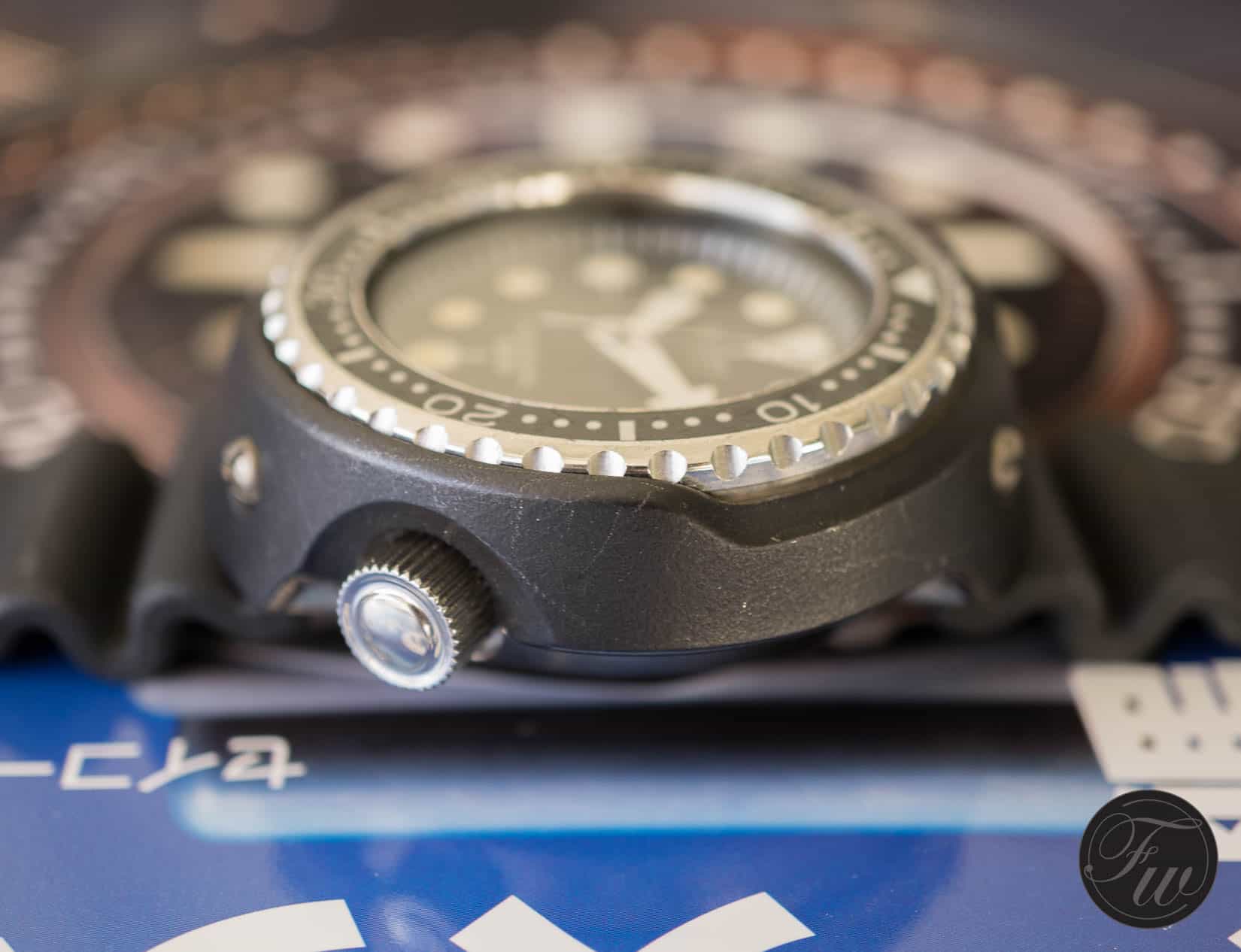
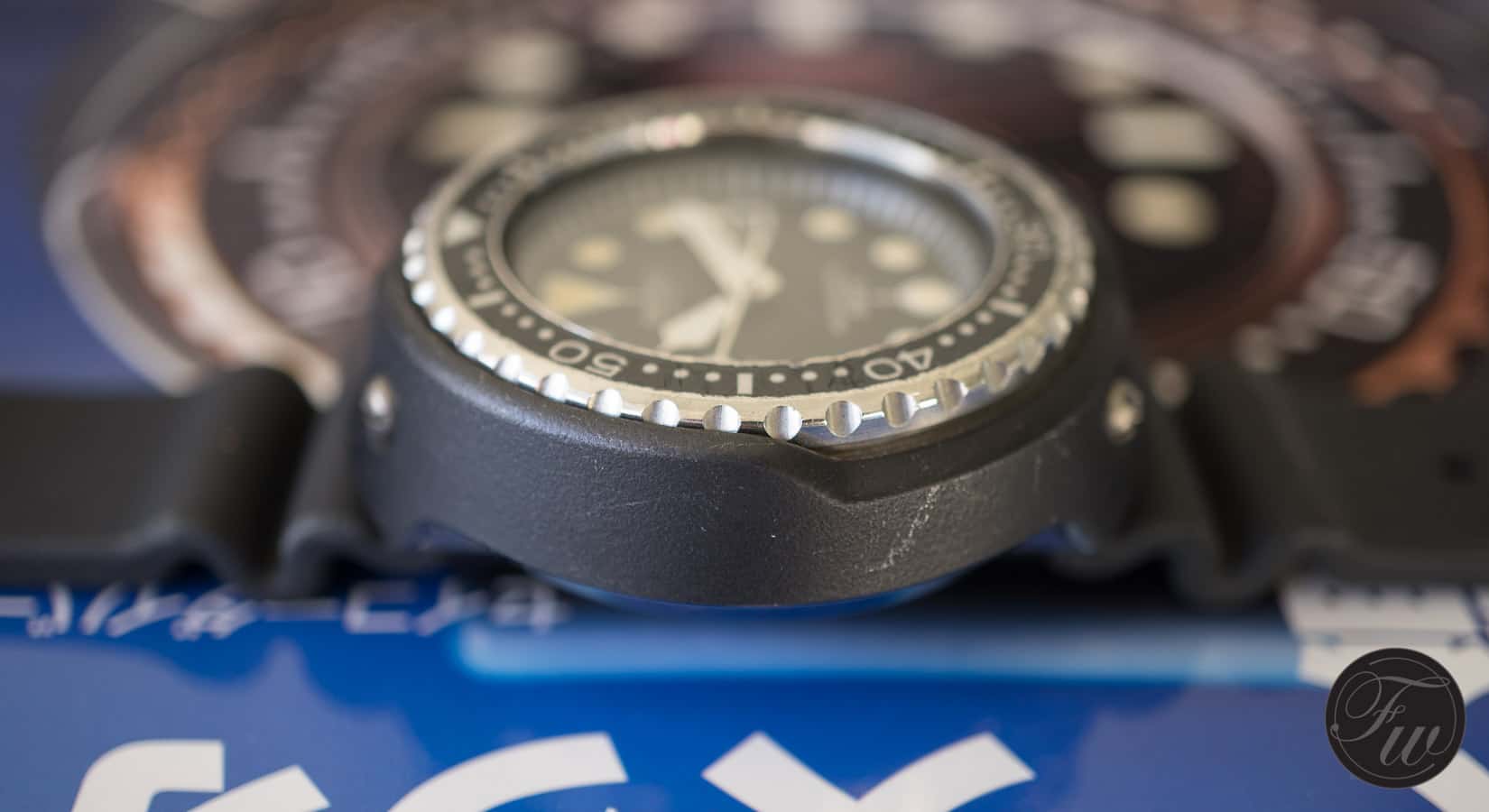
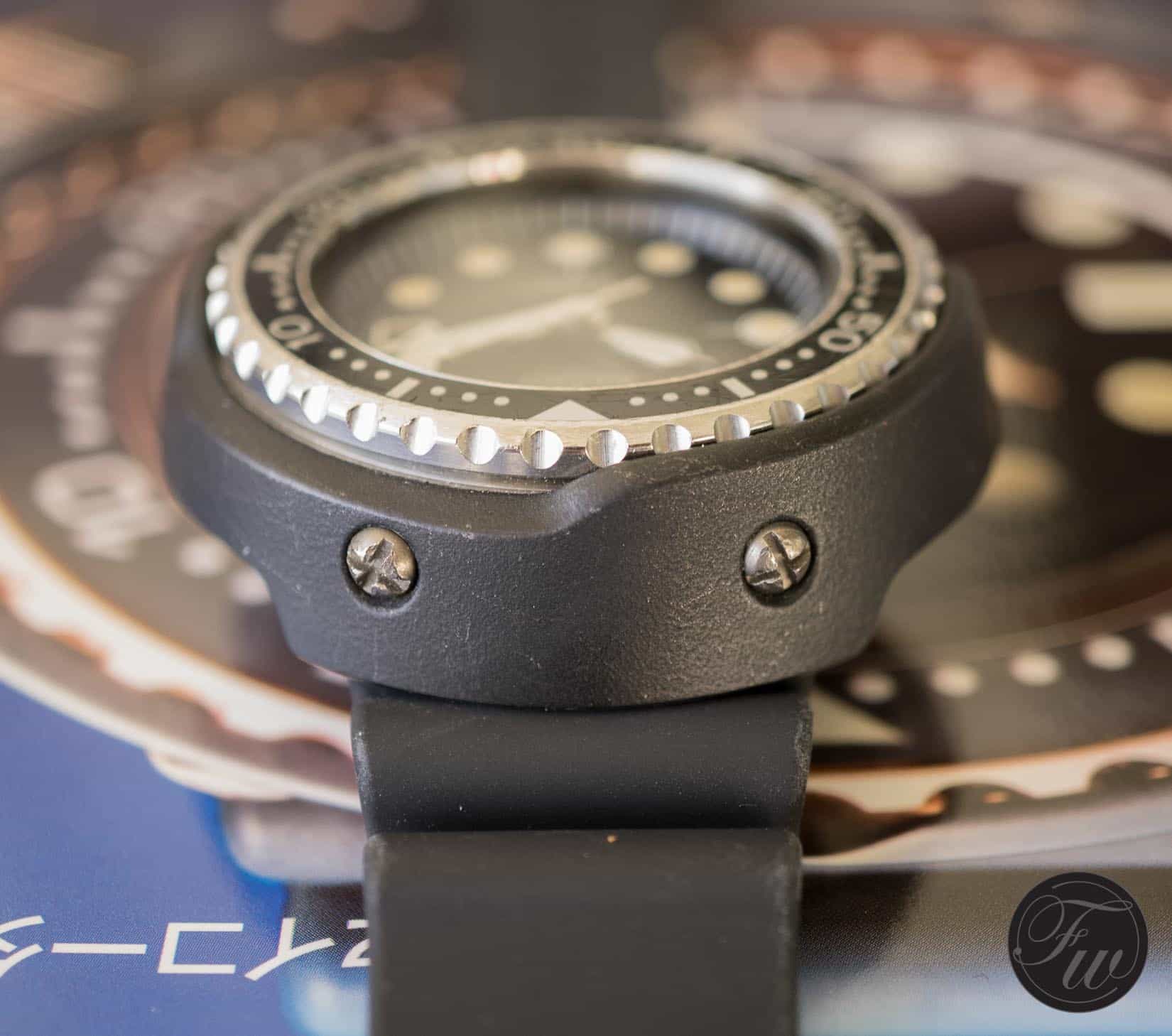 The accuracy of the Seiko 6159-7010 is amazing after all these years. The only concern I have about this watch is to have it serviced. The monobloc case and old movement most probably require it to go back to Japan for a Spa treatment.
The accuracy of the Seiko 6159-7010 is amazing after all these years. The only concern I have about this watch is to have it serviced. The monobloc case and old movement most probably require it to go back to Japan for a Spa treatment.
Talking about the monobloc case; this and the used L-shaped gasket to seal the watch are the reason that it doesn’t need a helium valve, like the Sea-Dweller. This Tuna as well as the Ploprof used cased made from one piece to keep it water and air-tight. See below a picture of the monobloc case and L-gasket from a later reference.
 The Seiko Tuna or ‘Hockey Puck’, is an interesting piece to wear. Most people think it is really ugly, but those who understand will love it. This watch wasn’t always referred to as Tuna, the story goes that on one of the Seiko forums, an owner of this model wrote that ‘it was like walking around with a can of tuna strapped to the wrist”. “Tuna cans” was also a much used phrase at the time (10-12 years ago), which eventually got shortened to Tuna. Other Seiko divers watches with the shrouds were also called Tuna or Baby Tuna, for the smaller sized models. As this watch is big! You have to deal with 50mm on your wrist, which is not for everyone (although Mike has one as well). The Baby Tuna models are an outcome for those who want to wear these shrouded divers anyway. The 50mm sized black case also justifies the Hockey Puck reference of course.
The Seiko Tuna or ‘Hockey Puck’, is an interesting piece to wear. Most people think it is really ugly, but those who understand will love it. This watch wasn’t always referred to as Tuna, the story goes that on one of the Seiko forums, an owner of this model wrote that ‘it was like walking around with a can of tuna strapped to the wrist”. “Tuna cans” was also a much used phrase at the time (10-12 years ago), which eventually got shortened to Tuna. Other Seiko divers watches with the shrouds were also called Tuna or Baby Tuna, for the smaller sized models. As this watch is big! You have to deal with 50mm on your wrist, which is not for everyone (although Mike has one as well). The Baby Tuna models are an outcome for those who want to wear these shrouded divers anyway. The 50mm sized black case also justifies the Hockey Puck reference of course.
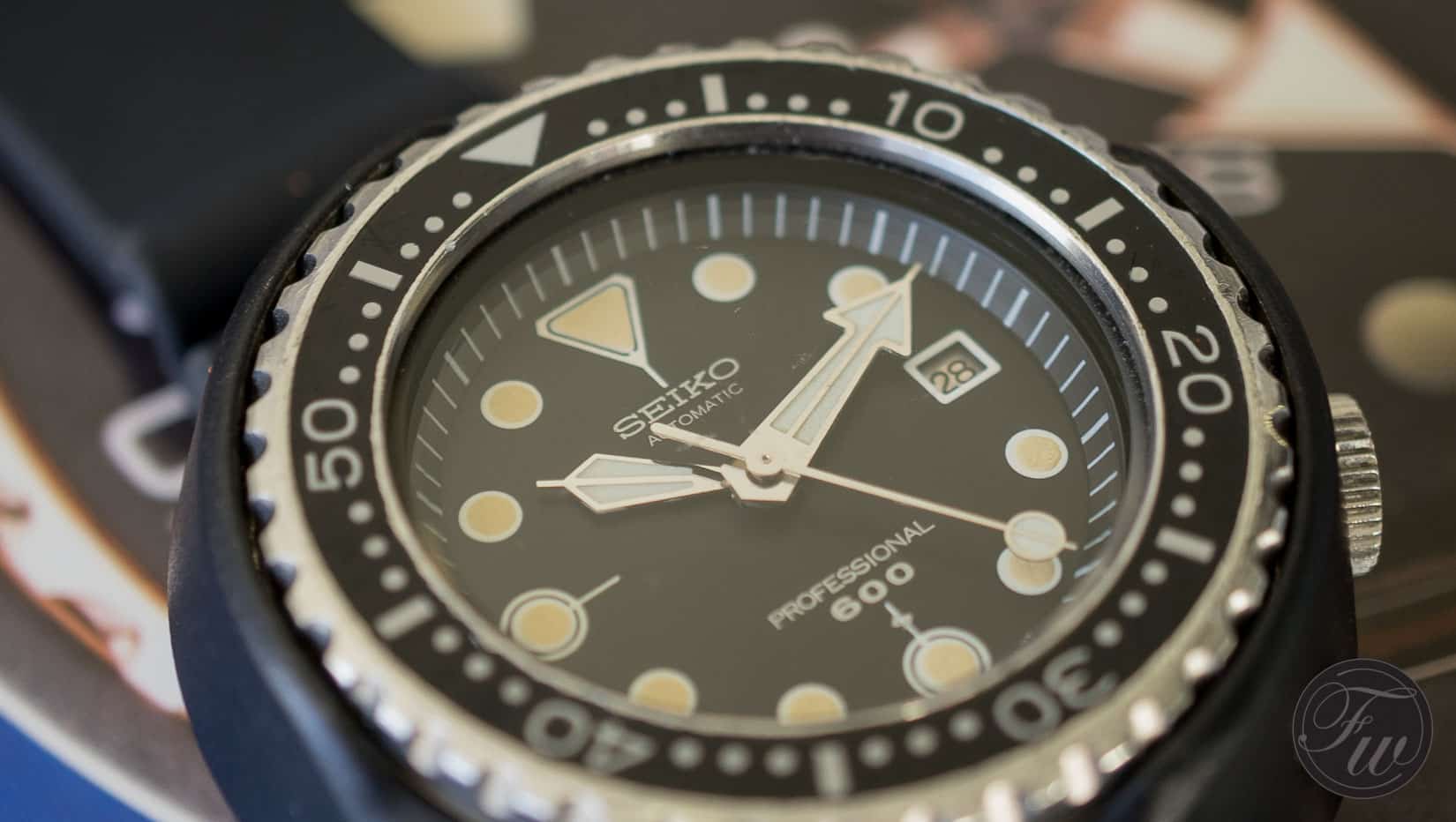
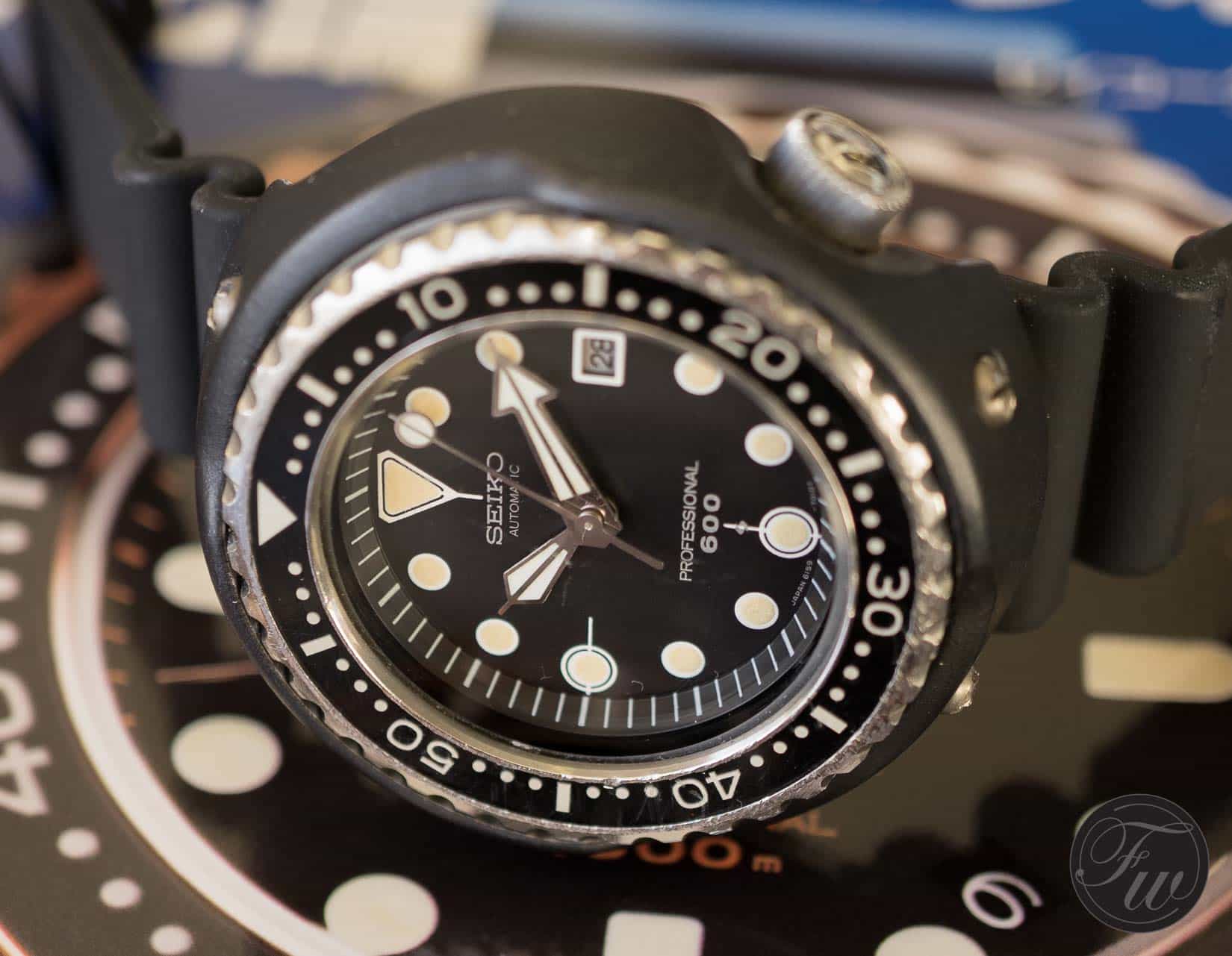 In the end, I am very happy with the Seiko 6159-7010 as it has a nicely discolored hour markers and hands (slightly yellow-ish) and the steel bezel with black shrouds give the watch a nice contrast. Despite the ceramic coated titanium shroud and titanium case, this is a pretty heavy watch, mainly due to its size I guess. Although I have no urge in getting a SBDX011 or current SBDX013 as well, the Spring Drive version could be something to consider in the future.
In the end, I am very happy with the Seiko 6159-7010 as it has a nicely discolored hour markers and hands (slightly yellow-ish) and the steel bezel with black shrouds give the watch a nice contrast. Despite the ceramic coated titanium shroud and titanium case, this is a pretty heavy watch, mainly due to its size I guess. Although I have no urge in getting a SBDX011 or current SBDX013 as well, the Spring Drive version could be something to consider in the future.

